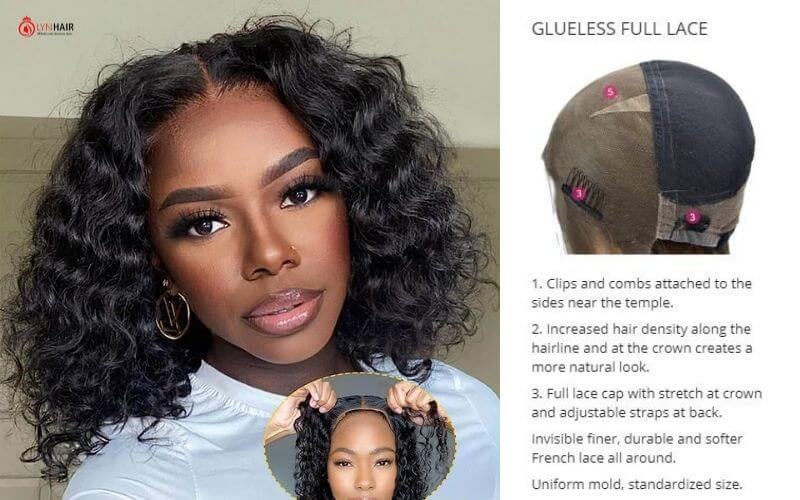The term “glueless wig” has been gaining prominence, offering a convenient and user-friendly alternative to traditional wigs that require adhesives. In this article, we’ll delve deeper into What is a glueless wig ? How they work, their benefits, and why they have gained immense popularity in the world of hair fashion and styling.
What are glueless wigs?

Glueless wigs are wigs that you can wear without using any glue or tape to attach them to your scalp. They have adjustable straps, combs, clips, or elastic bands to keep them securely in place without the need for adhesives. This makes them easy to put on and take off, and they are a good option for people who want a comfortable and convenient wig-wearing experience without using adhesive products.
Pros and cons of a glueless wig

Pros of Glueless Wigs:
- Easy and Quick: They’re simple to put on, perfect for quick hairstyle changes without adhesive hassle.
- Hair-Friendly: Protect your natural hair by avoiding damaging adhesives.
- Comfortable Fit: Adjustable straps and combs ensure a secure and comfy fit.
- Style Freedom: Available in various styles, textures, and lengths for versatile looks.
- Low Maintenance: Easier to manage, remove, and reapply compared to glued wigs.
Cons of Glueless Wigs:
- Security: May not be as secure as adhesive-based wigs, especially in windy conditions.
- Natural Hair Exposure: May not fully cover your natural hairline, requiring extra styling.
- Styling Limitations: Some complex hairstyles may be challenging to achieve.
How to install a glueless wig ?
Installing a glueless wig is a relatively simple process that doesn’t require adhesive or glue. Here are step-by-step instructions on how to install a glueless wig:
What You’ll Need:
- A glueless wig
- A wig cap (optional)
- Bobby pins or clips (optional)
- A wig grip or adjustable straps (included with some wigs)
Step 1: Prepare Your Hair
If you have long hair, it’s a good idea to braid or pin it close to your head to create a flat surface for the wig to sit on. This step is optional, but it can help ensure a more secure fit.
Step 2: Put on a Wig Cap (Optional)
Some people prefer to wear a wig cap to help secure their natural hair and create a smoother base. If you choose to use a wig cap, put it on before placing the wig.
Step 3: Adjust the Wig
Hold the wig by its ear tabs and flip it inside out. Adjust the straps or wig grip to fit your head size. Most glueless wigs come with adjustable straps to achieve a secure fit.

Step 4: Position the Wig
Place the wig on your head, starting from the front and pulling it back over your natural hair. Ensure that the wig’s front hairline aligns with your own, creating a natural look.
Step 5: Secure the Wig
Use the combs or clips attached to the wig to secure it in place. These are typically located at the front, sides, and back of the wig. Gently push the combs or clips into your natural hair to hold the wig firmly.
Step 6: Adjust and Style
Once the wig is securely in place, adjust it as needed to ensure a comfortable and natural fit. You can part the wig, style it, and make any necessary tweaks to achieve your desired look.
Step 7: Final Touches
After styling, use bobby pins or clips if needed to further secure the wig in place. This step is optional but can provide extra stability, especially for longer or heavier wigs.
Step 8: Blend with Natural Hair (if applicable)
If you have natural hair exposed at the front, you can blend it with the wig’s hairline to create a seamless transition.
That’s it! Your glueless wig should now be securely installed and ready to wear. Remember to follow any care instructions provided with the wig to maintain its quality and appearance. Additionally, you can customize your glueless wig further with different styles and accessories to achieve your desired look.
How long does a glueless wig last?

A glueless wig installation typically offers a shorter-term solution compared to wigs secured with adhesives, typically lasting around 2-4 weeks. These wigs are designed with combs or clips that secure them to your natural hair, which generally causes less damage than adhesive-based installations. Nevertheless, proper care is still essential to maximize their lifespan. This includes avoiding the use of hair products and minimizing exposure to heat styling, as it can help maintain the wig’s quality and keep it looking its best throughout its wear period.
FAQS – A Glueless Wig
1. Can any wig be glueless?

Not all wigs are inherently glueless. Glueless wigs are designed with features like combs, clips, adjustable straps, or wig grips that eliminate the need for adhesives. Regular wigs may require adhesive products for secure attachment.
2. How do you know if a wig is glueless?
You can identify a glueless wig by checking for built-in combs, clips, adjustable straps, or a wig grip. These features are indicative of a wig designed for adhesive-free application. Additionally, product descriptions and labels often specify if a wig is glueless.
3. Can you glue down a glueless wig?

While you can technically use adhesives on a glueless wig, it defeats the purpose of its design. Glueless wigs are meant to be worn without adhesives for easy application and removal. If you prefer a more secure attachment, it’s better to choose a wig designed for adhesive use.
𝑭𝒐𝒓 𝒎𝒐𝒓𝒆 𝒊𝒏𝒇𝒐𝒓𝒎𝒂𝒕𝒊𝒐𝒏, 𝒄𝒐𝒏𝒕𝒂𝒄𝒕:
Whatsapp: +84898890054
Follow us on Instagram: @ownhumanhairbusiness and @lynhair.factory
Website: hairbusiness.org

